 |
Home | Charity | Feedback |
Austria:
Innsbruck,
Salzburg,
Vienna,
Werfen
Vienna, Austria: A never ending romance by Prakash Bang, Editor in Chief  Hundreds of bridges, tens of parks, flowing water fountains, soothing river snaking its way around, creative murals, majestic palaces, array of museums, historic buildings and brightly painted trams on the city’s tree lined boulevards make Vienna, the Capital city of Austria truly charming. It’s very easy for a visitor to fall in love. 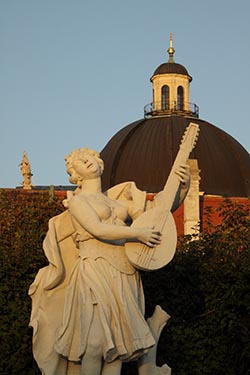 We were touring Central Europe. Austria was the 2nd country on our tour itinerary. The other four being Hungary, Liechtenstein, Slovakia and Czech Republic. After 2 days of good time in Innsbruck, we arrived in Vienna. For our journey, we took Railjet No 163 that left Innsbruck at 12:06PM and reached Vienna (Station: Wien Westbahnhof) at 16:44PM. Due to some work on the railroad, the arrival was delayed by about 10 minutes… a rare thing to happen given Europe’s fine rail network.
We were touring Central Europe. Austria was the 2nd country on our tour itinerary. The other four being Hungary, Liechtenstein, Slovakia and Czech Republic. After 2 days of good time in Innsbruck, we arrived in Vienna. For our journey, we took Railjet No 163 that left Innsbruck at 12:06PM and reached Vienna (Station: Wien Westbahnhof) at 16:44PM. Due to some work on the railroad, the arrival was delayed by about 10 minutes… a rare thing to happen given Europe’s fine rail network.
We would be in Vienna for 3 days. For our stay we were booked at Austria Trend Hotel Savoyen Vienna. This was a fine hotel on Rennweg 16, one of the important roads almost in the heart of the city. The hotel was within walking distance to the Belvedere Palace and the Soviet War Memorial located at Schwarzenbergplatz. Thanks to being associated with the travel trade, the management of the hotel was kind enough to upgrade us to their suites located on the 7th floor. It was a large suite with 2 big rooms and an equally big bathroom. The room overlooked many of the city’s domes and spires. And to chill, we had a complimentary bar that was full to the brim. If you do get a chance to be in Vienna, try staying at Hotel Savoyen. It has my recommendation… they look after you well. 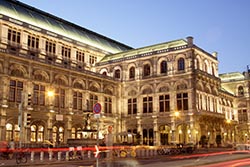 We took a taxi from the station to reach our hotel. The ride took about 25 minutes and cost us under Euro 20. The drive gave us some city-bearings. After resting a while in our plush rooms, we were ready to walk for the evening. In less than 15 minutes, we were at Lower Belvedere. The entrance to the Palace was directly from Rennweg Street.
We took a taxi from the station to reach our hotel. The ride took about 25 minutes and cost us under Euro 20. The drive gave us some city-bearings. After resting a while in our plush rooms, we were ready to walk for the evening. In less than 15 minutes, we were at Lower Belvedere. The entrance to the Palace was directly from Rennweg Street.
The Belvedere is a historical building complex consisting of two Baroque palaces the Upper and Lower Belvedere, the Orangery, and the Palace Stables. The buildings are set in a Baroque park landscape in the 3rd district of the city, south-east of its centre. It houses the Belvedere museum. The grounds are set on a gentle gradient and include decorative tiered fountains and cascades, Baroque sculptures, and majestic wrought iron gates. The Baroque palace complex was built as a summer residence for Prince Eugene of Savoy. The Belvedere was built during a period of extensive constructions in Vienna, which at the time was both the imperial capital and home to the ruling dynasty. This period of prosperity followed on from the commander-in-chief Prince Eugene of Savoy's successful conclusion of a series of wars against the Ottoman Empire. 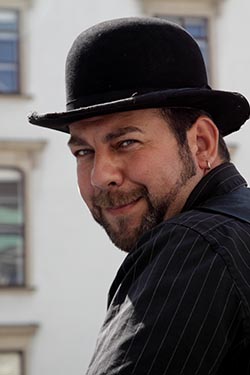 After walking in the gardens of Lower Belvedere, we moved towards Schwarzenbergplatz, one of the most important and busy squares of Vienna. Located here is the Soviet War Memorial.
After walking in the gardens of Lower Belvedere, we moved towards Schwarzenbergplatz, one of the most important and busy squares of Vienna. Located here is the Soviet War Memorial.
The Soviet War Memorial is formally known as as the Heldendenkmal der Roten Armee (Heroes' Monument of the Red Army). The semi-circular white marble colonnade partially enclosing a twelve-metre figure of a Red Army Soldier was unveiled in 1945. The Heroes' Monument of the Red Army in Vienna was built to commemorate 17,000 Soviet soldiers who fell in the Battle for Vienna of World War II. A large water fountain and ample open space make the monument a favourite for locals as well. We continued walking till we reached Ring Boulevard or Ringstrasse - a 4 km of tree lined road. The construction of the Ring Boulevard was initiated by Emperor Franz Joseph I in December 1857. The magnificent road was erected on the free space, which emerged after tearing down the former city walls, glacis and military enforcements protecting the city center - today's first district locally known as Innere Stadt. By this the emperor hoped to overcome the separation of city center and the suburbs, which had officially become part of Vienna in 1850. Ring Boulevard was generously planned, leaving sufficient space for a shaded avenue and monumental buildings like Hofburg, Austrian Parliament, State Opera House, Museum of Fine Arts, the first public observatory Urania and Vienna University among others. We planned to see many of the buildings the next day. 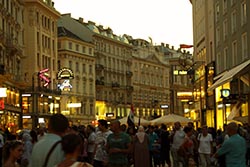 After walking up to the State Opera House, we decided to turn back. For dinner we grabbed a slice of pizza from one of the many kiosks in the neighbourhood. We took a taxi back to the hotel. Rest was in place to prepare us for a long day tomorrow.
After walking up to the State Opera House, we decided to turn back. For dinner we grabbed a slice of pizza from one of the many kiosks in the neighbourhood. We took a taxi back to the hotel. Rest was in place to prepare us for a long day tomorrow.
The next morning, after a sumptuous breakfast we took a taxi and alighted at the State Opera House which is the departure point for most of the city-tour buses. One sight that no tourist would give a miss is a visit to the Schonbrunn Palace. There was a 3 hour tour that would give a ride through the city and included a visit to the Schonbrunn Palace. The cost per person was Euro 39. On hindsight, I think this trip could be best ignored; instead a visit to the palace independently has my vote. The only saving grace of the trip was that the entrance fee to the palace was included and since we were in a group, the line was shorter. 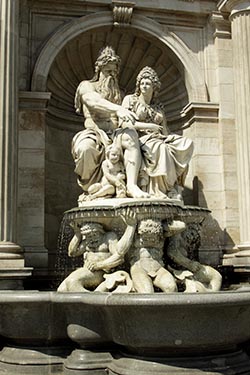 Schonbrunn Palace is a former imperial 1400-room Rococo summer residence. The palace and gardens illustrate the tastes, interests, and aspirations of successive Habsburg monarchs. In the year 1569, Holy Roman Emperor Maximilian II purchased a large floodplain of the Wien river beneath a hill, situated between Meidling and Hietzing, where a former owner, in 1548, had erected a mansion called Katterburg. The emperor ordered the area to be fenced and put game there such as pheasants, ducks, deer and boar, in order to serve as the court's recreational hunting ground. The name Schönbrunn (meaning "beautiful spring"), has its roots in an artesian well from which water was consumed by the court. During the next century, the area was used as a hunting and recreation ground. Especially Eleonora Gonzaga, who loved hunting, spent much time there and was bequeathed the area as her widow's residence after the death of her husband, Ferdinand II. From 1638 to 1643, she added a palace to the Katterburg mansion. The palace has many other attractions including the French and English gardens; Palm House; Botanical garden; marble structures of deities and the awe-inspiring Gloriette structure standing on a hill overlooking the palace and the city. A guided tour took us through the many stately rooms of the palace. Pictures will tell you more.
Schonbrunn Palace is a former imperial 1400-room Rococo summer residence. The palace and gardens illustrate the tastes, interests, and aspirations of successive Habsburg monarchs. In the year 1569, Holy Roman Emperor Maximilian II purchased a large floodplain of the Wien river beneath a hill, situated between Meidling and Hietzing, where a former owner, in 1548, had erected a mansion called Katterburg. The emperor ordered the area to be fenced and put game there such as pheasants, ducks, deer and boar, in order to serve as the court's recreational hunting ground. The name Schönbrunn (meaning "beautiful spring"), has its roots in an artesian well from which water was consumed by the court. During the next century, the area was used as a hunting and recreation ground. Especially Eleonora Gonzaga, who loved hunting, spent much time there and was bequeathed the area as her widow's residence after the death of her husband, Ferdinand II. From 1638 to 1643, she added a palace to the Katterburg mansion. The palace has many other attractions including the French and English gardens; Palm House; Botanical garden; marble structures of deities and the awe-inspiring Gloriette structure standing on a hill overlooking the palace and the city. A guided tour took us through the many stately rooms of the palace. Pictures will tell you more.
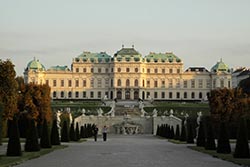 After about 3 hours, we were dropped back near the Opera House. Whilst exploring the neighbourhood, in one of the squares, we were intrigued to take a horse-driven buggy. Euro 95 was the cost for 4 people for a 60-minute tour along the Ring Boulevard and its many places of modern and historical significance. The buggy-driver was very enthusiastic and gave a good narration. I think this tour is recommended especially if you want to avoid hours of walking.
After about 3 hours, we were dropped back near the Opera House. Whilst exploring the neighbourhood, in one of the squares, we were intrigued to take a horse-driven buggy. Euro 95 was the cost for 4 people for a 60-minute tour along the Ring Boulevard and its many places of modern and historical significance. The buggy-driver was very enthusiastic and gave a good narration. I think this tour is recommended especially if you want to avoid hours of walking.
After the buggy ride, we took a taxi back to our hotel. Our plan was to give our back some rest and began our exploration later in the evening. 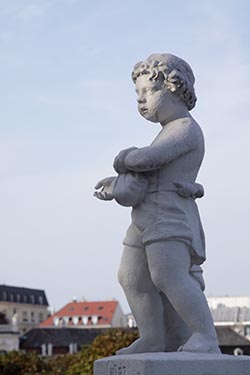 Our evening trip began with a visit to Upper Belvedere. The entrance is on Prinz Eugen Street, a road that runs parallel to Rennweg. After exploring the palace’s beautiful gardens and pond we walked all the way to Karntner Street that links Ring Boulevard with St Stephen’s Cathedral – another Vienna icon.
Our evening trip began with a visit to Upper Belvedere. The entrance is on Prinz Eugen Street, a road that runs parallel to Rennweg. After exploring the palace’s beautiful gardens and pond we walked all the way to Karntner Street that links Ring Boulevard with St Stephen’s Cathedral – another Vienna icon.
Karntner Street is Vienna’s most famous and happening shopping street. On both sides are stores selling up market brands as also countless restaurants, bars and bistros. By the time we reached the street, evening had set in prompting the street lights, shops’ signage and neon to light up. Street performers kept the crowds busy. For dinner, we opted for an Italian restaurant. Pizza and risotto did the trick. After dinner we continued walking to reach the famous cathedral. St. Stephen's Cathedral is the mother church of the Archdiocese of Vienna and the seat of the Archbishop of Vienna. Its current Romanesque and Gothic form seen today, was largely initiated by Rudolf IV and stands on the ruins of two earlier churches, the first being a parish church consecrated in 1147. As the most important religious building in Austria's capital, the cathedral has borne witness to many important events in the nation's history and has, with its multi-colored tile roof, become one of the city's most recognizable symbols. At the time of my visit, the cathedral was undergoing renovation. It was almost 10PM. Time to get back to the hotel. The next morning we would take a jet boat to visit another country’s Capital city – Bratislava. Vienna Image Gallery  Photo viewer Photo viewer
|
|
|
Home |
Charity |
Feedback
Privacy Policy | Terms of Usage © YoGoYo.com. All rights reserved. |



























































